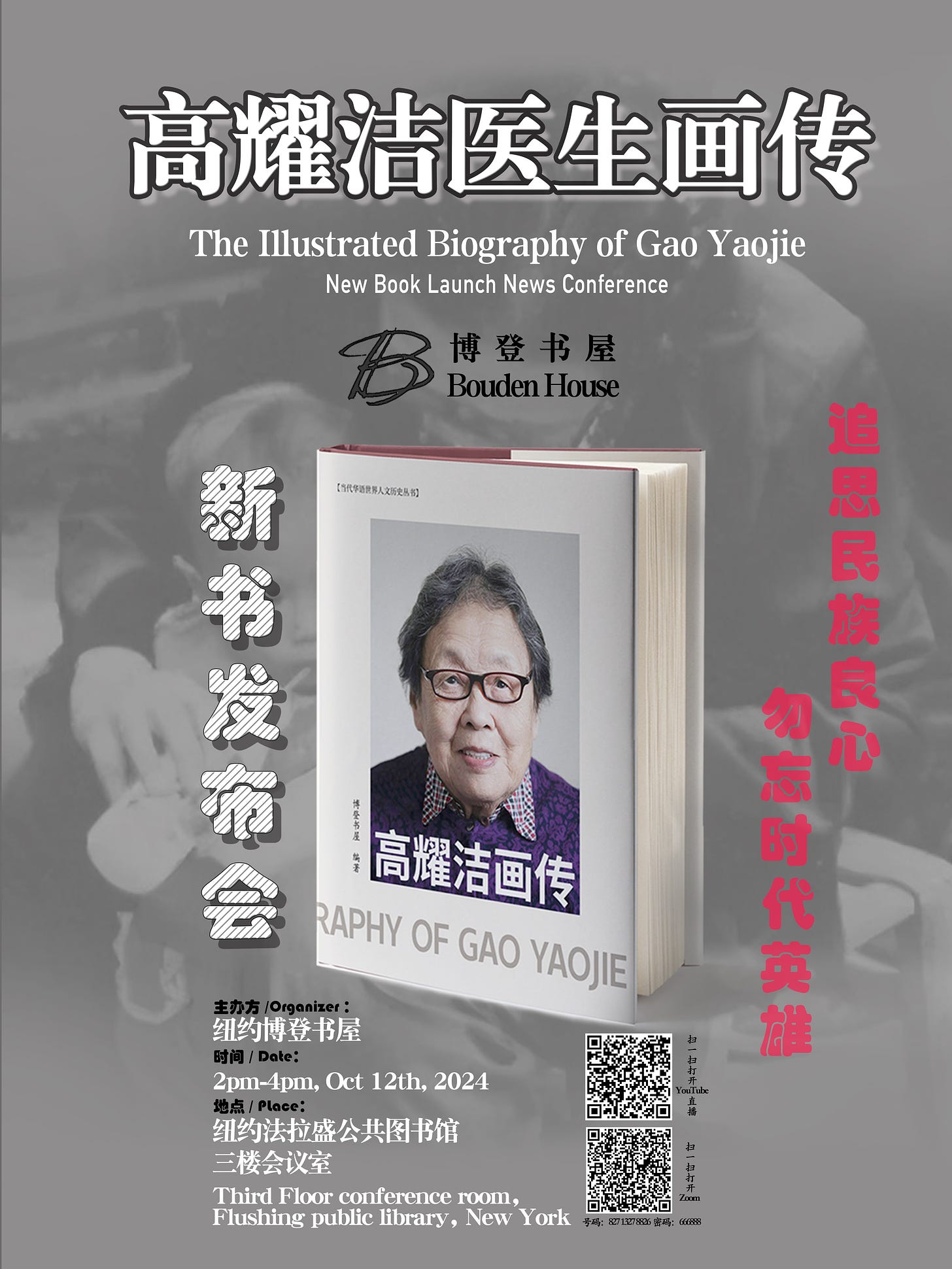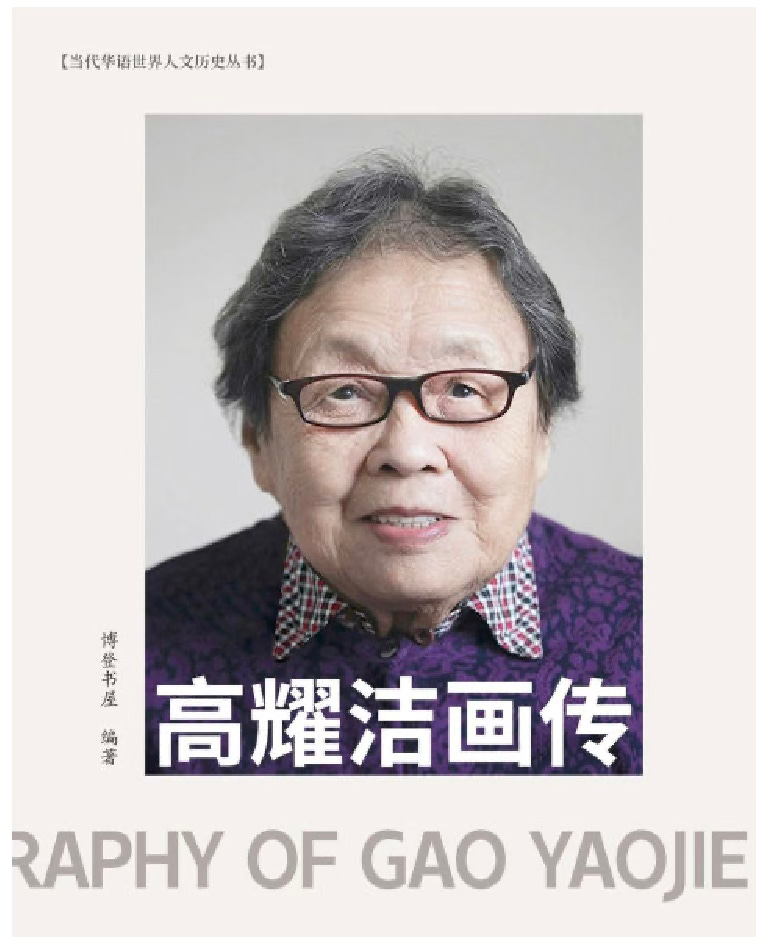編者按:2023年12月10日高耀潔醫生在紐約去世。博登書屋編輯出版中英文《高耀潔畫傳》,希拉里·罗德姆·克林顿和黎安友教授分別為畫傳寫下前言:“读着这本汇集了高耀洁生平照片、文字说明和怀念的诗歌和文章的《高耀洁画传》,让我想到因高医生来到纽约,我从而得到了一种罕见的特权和愉悦。随着岁月的流逝,我很幸运地越来越了解她,经历了她的力量、决心、道义责任以及她对贫困、虚弱和受苦者的爱和关怀。”另:《高耀洁画传》新書發佈會10月12日在紐約法拉盛舉行。
看到这本书中展示的高医生的生活照片、图片说明以及感性而深思的诗歌时,许多回忆涌上心头。
有些是她告诉我的故事的回忆:医学院、幸福的婚姻、她的孩子们,有些是她在产科工作时的紧迫场面。然后是文化大革命期间不公正的苦难岁月,她被殴打,为了止血做了“胃次全切除术”。从那以后,她再也无法像普通人一样进食,只能依靠少吃多餐一点清淡食物维持生命。接着是陉山采石场劳动改造的生活。1973 年郑州市革命委员会正式宣布对她给予以平反,恢复名誉,她得以重返所想往的临床和教学工作。
上世纪 80 年代是高医生职业生涯中取得巨大成功和声誉的时期,她被全国公认为杰出的医生和教师。然而,她一直以拯救病重的患者为己任,满怀热情地工作。即使退休后,她仍继续讲课和写作,致力于教导农村妇女如何预防性疾病的宣导和教育。
1996 年,她与一位患有神秘且不治之症的女性相遇。结果证明这位病人患上了艾滋病。这次经历启发她去寻找这位女性生病的原因,她走进了农村村庄,发现了在河南村庄间传播这种致命疾病的血液丑闻。她和朋友杜聪一起不知疲倦地访问村庄,照顾垂危的人们,抱着生病的孩子,用自己的退休金购买药物。她坐在村庄里的房屋里,目睹人们的死亡,一家一家地安慰着在子宫中感染病毒的孩子和他们悲伤的母亲。同时,她向村民发放艾滋病预防手册,并在中国各大学广泛宣讲这个问题。
2007 年,高医生来到美国讲学,我在哥伦比亚大学担任她的演讲主持人时与她相遇。这本书中的一张照片让我想起了这个场景,这是我们的第一次见面,也成为了我们之间长久的友谊的开始。也是在这次旅行中,高医生遇到了时任国务卿的希拉里·克林顿——高医生非常珍视他们之间的这段关系。
在中国,高医生的声誉继续增长,她在艾滋病问题上讲学和撰文,并继续访问村庄,照顾艾滋病孤儿。于此同时,她面临着越来越大的压力。 2009年她不得不最后一次离开中国。在德克萨斯州短暂停留后,她于 2010 年 3 月来到纽约,住在曼哈顿百老汇大道3333号 C8D 的一间公寓。之后的 13年,她一直住在那里。
这本书中的照片展示了她的公寓,以及她如何努力地撰写更多书籍,有些是关于她的生活,有些是关于中国近期历史,有些是关于性健康教育。看到她在校园上、在公寓周围散步、在地铁站、在公寓里照顾她心爱的植物——这让我想起她身体健康时的一些快乐时光。尽管她成了流亡者,不能再为河南村庄的心爱患者服务了,她在中国仍然非常受欢迎——受人民欢迎,而非政府。来自中国的学生和访客会到公寓帮助她,电脑输入文章,或带她散步。
遗憾的是,2013年后,她身体逐渐衰退,她开始需要兼职家庭护理人员照顾起居。之后,她健康开始恶化,她因肺炎入院,这是数次住院中的一次。随之需要全职的健康护理人员。身体虽然不佳, 2019年我陪同希拉里·克林顿来到公寓拜访她,她感到非常高兴。这本书中的一张照片,让我想起那个快乐的时刻。
高医生一直写作,直到最后一刻。临终前她还完成了另一本书。就在我写这篇序言的时候,这本书也即将出版。
读着这本汇集了高耀洁生平照片、文字说明和怀念的诗歌和文章的《高耀洁画传》,让我想到因高医生来到纽约,我从而得到了一种罕见的特权和愉悦。随着岁月的流逝,我很幸运地越来越了解她,经历了她的力量、决心、道义责任以及她对贫困、虚弱和受苦者的爱和关怀。
黎安友
2024年 3月 13日于纽约
In Memory of Gao Yaojie
So many memories come back when I see Dr. Gao’s life laid out in this book in photographs and their captions and in emotional and reflective poems.
Some are memories of stories she told me: medical school, a happy marriage, children,and the intense urgency of her work in the obstetrics department. Then, the horrible years of unjust suffering during the cultural revolution, when she was beaten and a subtotal gastrectomywas performed to stop the bleeding. She was never able to eat like a normal person after that,surviving on repeated small meals of bland food. Next was the life of labor reform at the Xing Mountain Quarry. Then came three years in labor re-education camp, and finally in 1973 the satisfaction of having the Zhengzhou Municipal Revolutionary Committee formally state that the sentence was in error. She was exonerated and her reputation was restored. From there she returned to her Important clinical and teaching work, where she longed to go.
The 1980s were a period for Dr. Gao of great professional success and distinction, with nationwide recognition as an outstanding doctor and teacher. Yet always, saving the patients who were most ill was her passion and commitment. Even after retirement, she continued to lecture and write in her mission of teaching rural women how to avoid sexual diseases.
In 1996, she had an encounter with a woman with a mysterious and incurable illness. It turned out to be AIDS. This encounter set her off on a search to find out how the woman got sick, and this led her to the rural villages, where she discovered the blood scandal that was spreading the fatal disease among the men and women of Henan villages. Working with her friend Du Cong, she visited the villages tirelessly, attended the dying, held the sick children in
her lap, delivered medicine paid for with her retirement money. One family at a time, she sat in the village houses and watched people die, comforted the babies who were infected in the womb and their grieving mothers. At the same time, she distributed booklets on how to avoid AIDS to the villagers and lectured widely on the problem in Chinese universities.
In 2007, Dr. Gao came to the United States to lecture, and I met her at Columbia when I served as the host for her lecture. A photograph in this book reminds me of this, my first meeting in what turned out to be a long friendship. It was also on this trip that Dr. Gao met Secretary of State Hillary Clinton—a relationship Dr. Gao treasured deeply.
In China, Dr. Gao’s fame continued to grow, as she spoke and wrote on the AIDS issue and continued to visit the villages and care for the AIDS orphans. But pressure on her grew, and in 2009 she had to leave China for the last time. After spending a short time in Texas, she came to New York in March 2010 and soon moved to apartment C8D at 3333 Broadway, where she spent the last 13 years of her life.
Pictures in this book show her apartment and how hard she worked writing many more books, some on her life, some on China’s recent history, some on sexual health. Seeing pictures of her on campus, taking a walk around her building, on the subway station, caring for her beloved plants in her apartment – these remind me of some happy times she had when her health was still good, even though she had now become an exile and could no longer serve her beloved patients in the Henan villages. She was still very popular in China – with the people, not the government. Students and visitors from China would come by the apartment to help her with her writing or to take her out for a walk.
But sadly, the pictures show us her declining health. In 2013, she began to need part-time home health aides. Then she was hospitalized for pneumonia, one of several hospitalizations, and then needed full-time health aides. Still, she was thrilled when Hillary Clinton came to visit her at the apartment in 2019. A photograph in the book reminds me that I was there on that happy occasion.
Dr. Gao continued to write, up to the very end. She had finished one more book, which as I write this is due to be published in the near future.
This book of photos, captions, and verses reminds me of the rare privilege and pleasure that came to me, when Dr. Gao came to New York. I was fortunate to know her better and better as the years went by, and to experience her strength, determination, moral clarity, and her love and care for the poor, the weak, and those who suffer.
Andrew J. Nathan
New York
March 13, 2024






